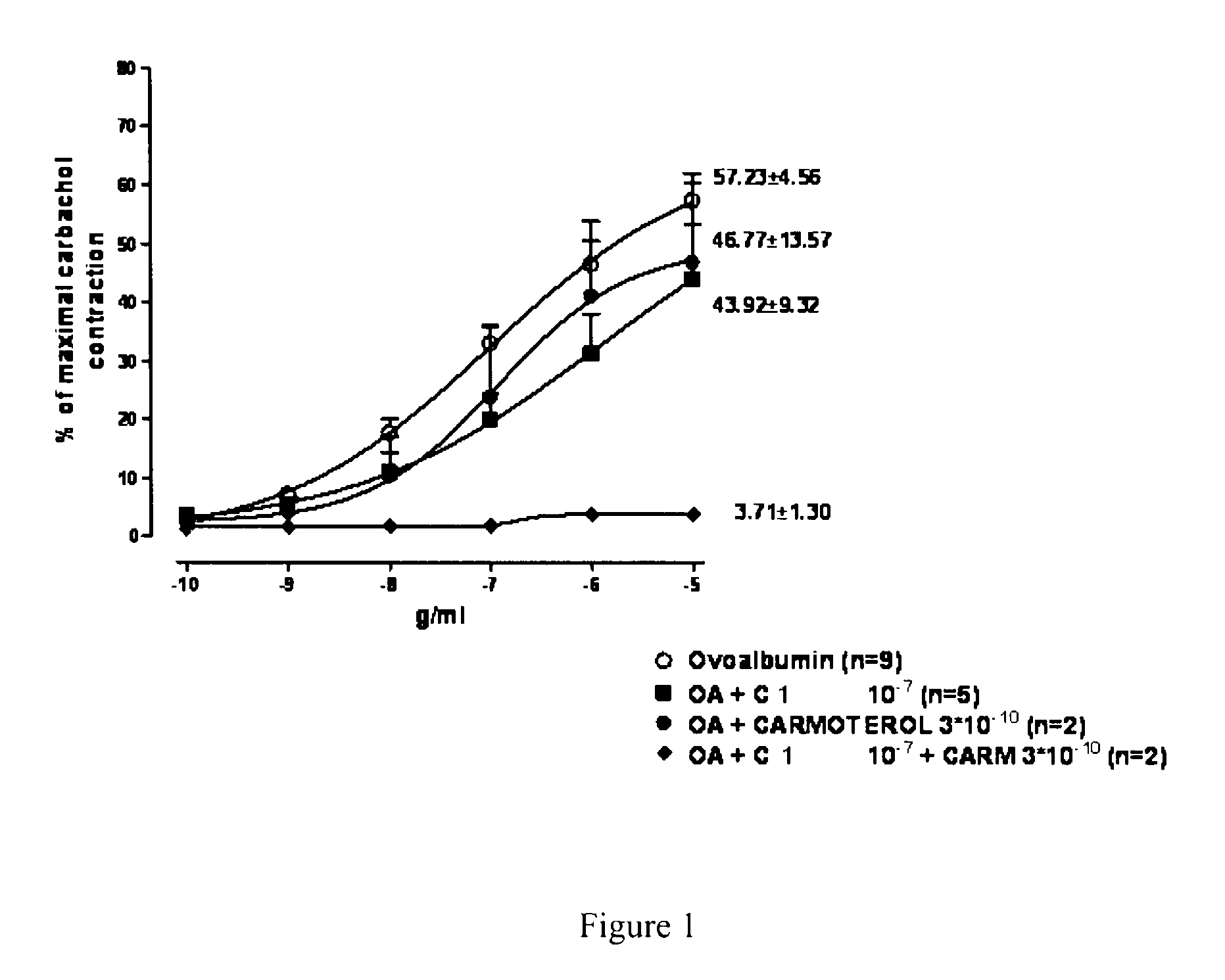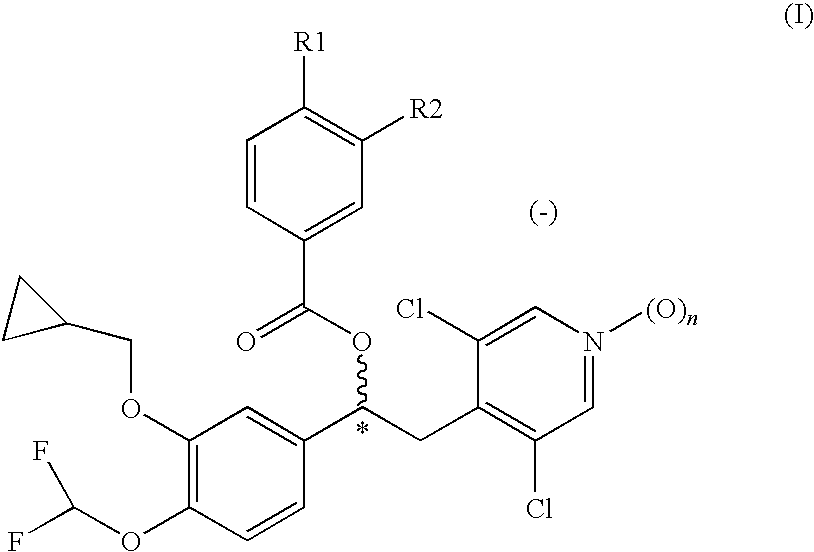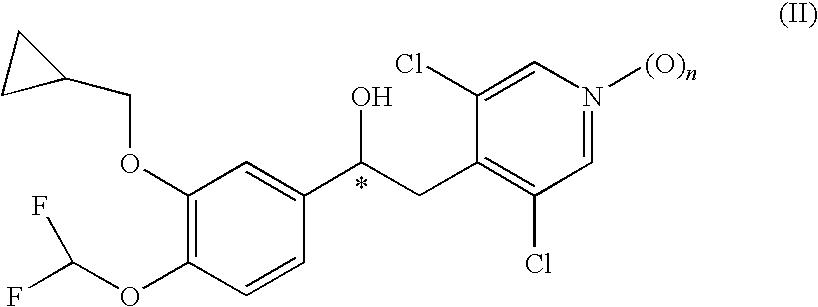1-phenyl-2-pyridinyl alkyl alcohol compounds as phosphodiesterase inhibitors
a technology of phosphodiesterase and alkyl alcohol, which is applied in the direction of drug composition, immunodeficiency, biocide, etc., can solve the problems of limited use of several pde4 inhibitors of the first-generation such as rolipram and piclamilast, and poor selectivity of compounds
- Summary
- Abstract
- Description
- Claims
- Application Information
AI Technical Summary
Benefits of technology
Problems solved by technology
Method used
Image
Examples
example 1
Preparation of 1-(3-Cyclopropylmethoxy-4-difluoromethoxy-phenyl)-2-(3,5-dichloro-pyridin-4-yl)-ethanol (3)
[0138]A solution of 3-cyclopropylmethoxy-4-difluoromethoxy-benzaldehyde (5.00 g) and 3,5-dichloro-4-methylpyridine (2.57 g) in 50 ml dry THF was cooled to −30° C. Solid potassium t-butoxide (tBuOK, 1.96 g) was added portionwise maintaining the temperature between −30° C. and −20° C., thus obtaining a dark red solution. After completion of the addition, the mixture was stirred at −30° C. for 1 hour. A saturated aqueous solution of NH4Cl (50 ml) was then added to the reaction mixture, maintaining the temperature between −5° C. and −10° C. The color of the reaction mixture turned to yellow.
[0139]The mixture was then extracted with EtOAc. The organic layer was dried over Na2SO4 and the solvent was removed by evaporation. The residue was treated with 30 ml of a mixture of petroleum ether / EtOAc=8 / 2; the precipitate was filtered and dried, obtaining 4.83 g of the title compound that wa...
example 2
Preparation of 1-(3-Cyclopropylmethoxy-4-difluoromethoxy-phenyl)-2-(3,5-dichloro-1-oxy-pyridin-4-yl)-ethanol (4)
[0141]Compound (3) (13.0 g) was dissolved in CH2Cl2 (250 ml) then m-chloro perbenzoic acid (16.5 g) was added, and the resulting solution was stirred at room temperature for 2 hours. Na2S2O3 (25.4 g) was added, and the mixture was vigorously stirred at r.t. for 1 hour. The solid residue was filtered off, the solution was washed with 1N NaOH (3×100 ml) then the organic phase was dried over Na2SO4 and the solvent was removed by evaporation to give 10.3 g of the desired product (4) as a white solid that was used in the next steps without further purification.
[0142]MS / ESI+ 420-422 [MH]+
example 3
Preparation of Acetoxy-phenyl-acetic acid 1-(3-cyclopropylmethoxy-4-difluoromethoxy-phenyl)-2-(3,5-dichloro-1-oxy-pyridin-4-yl)-ethyl ester (5, mixture of diastereoisomers)
[0143]Compound (4) (19.95 g), (S)-acetylmandelic acid (9.22 g), 1-ethyl-3-[3-dimethylamino propyl]carbodiimide hydrochloride (18 g), and 4-dimethylaminopyridine (2.89 g) were dissolved, under N2 atmosphere, in dry CH2Cl2 (300 ml). The reaction mixture was stirred at room temperature overnight. A 5% aqueous solution of NaHCO3 (200 ml) was added and the aqueous phase was extracted with CH2Cl2 (3×100 ml). The combined organic phases were dried over Na2SO4 and the solvent was evaporated under reduced pressure to give the title compound (5) as mixture of two diastereoisomers (32 g); separation of the two diastereoisomers is described in Examples 4 and 6.
PUM
| Property | Measurement | Unit |
|---|---|---|
| temperature | aaaaa | aaaaa |
| temperature | aaaaa | aaaaa |
| temperature | aaaaa | aaaaa |
Abstract
Description
Claims
Application Information
 Login to View More
Login to View More - R&D
- Intellectual Property
- Life Sciences
- Materials
- Tech Scout
- Unparalleled Data Quality
- Higher Quality Content
- 60% Fewer Hallucinations
Browse by: Latest US Patents, China's latest patents, Technical Efficacy Thesaurus, Application Domain, Technology Topic, Popular Technical Reports.
© 2025 PatSnap. All rights reserved.Legal|Privacy policy|Modern Slavery Act Transparency Statement|Sitemap|About US| Contact US: help@patsnap.com



